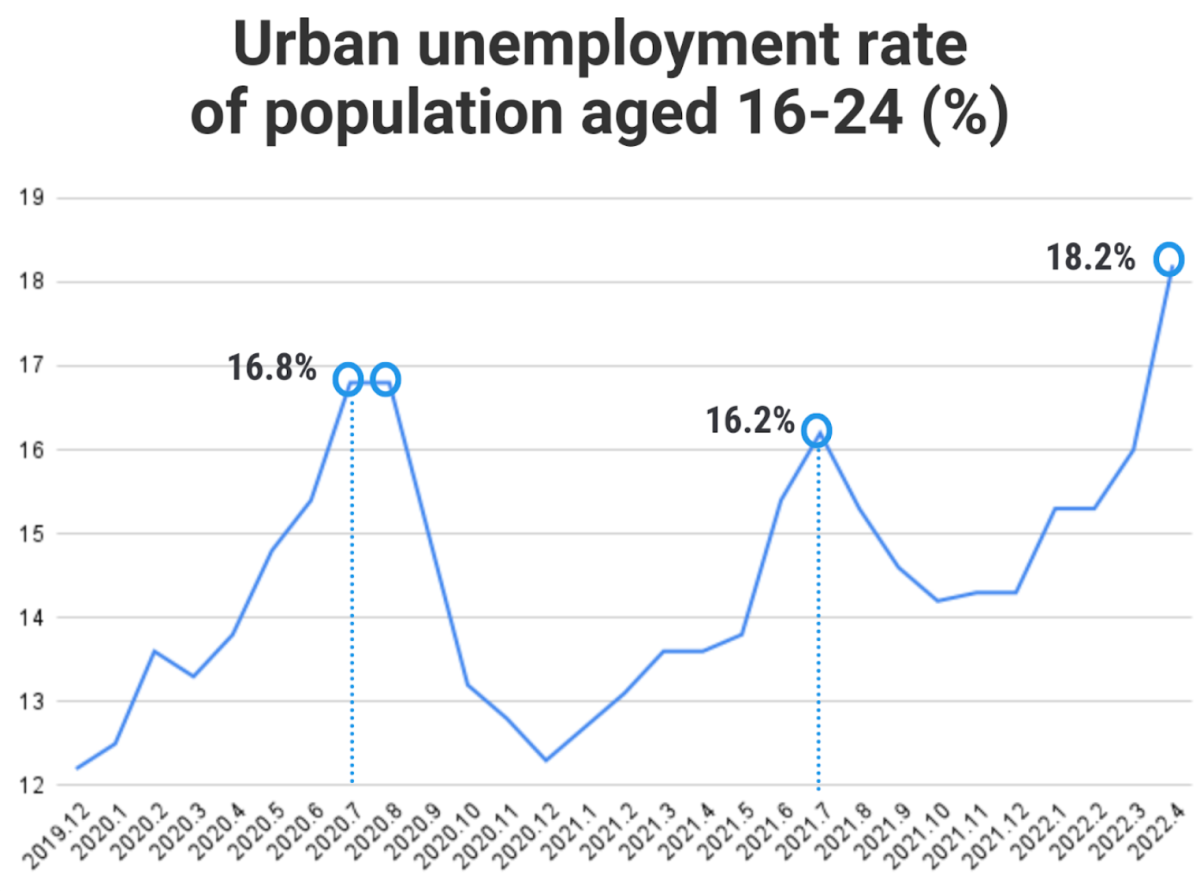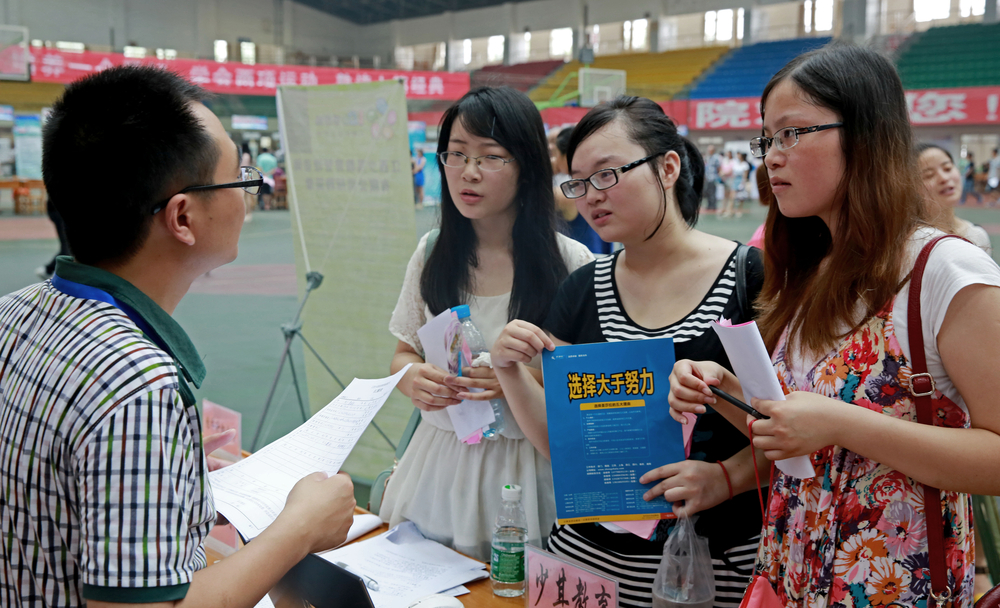China’s urban unemployment rate rose to 6.1 percent in May 2022, almost reaching the same rate recorded during the initial outbreak of the pandemic, according to data released by the National Bureau of Statistics. The unemployment rate of those 16-24 years old is particularly high, reaching 18.2 percent in April, the highest level in history and almost double the next highest rate recorded, in April 2019 (9.9 percent).

Typically, peaks in youth unemployment occur annually in the graduation period of July and August. With the unemployment rate already reaching such levels this spring, it is likely to rise further.
The latest Covid-19 wave triggered this sharp rise, as lockdowns and production shutdowns have slowed economic growth and reduced labour demand. The higher education system continues to produce large numbers of graduates, intensifying job competition and other structural issues.
A recent graduate interviewed by Jiemian about her difficult job search said, "I think you only have options when you have the resources. If you don't have the resources, you can only do your best and take what you can get.”
University graduates see delay in entering the job market
The number of university graduates has been growing for a decade and is expected to reach 10.76 million this year, the highest in ten years. The annual growth of university graduates has tended to hover at around 300,000, but this year, the number of graduates increased by five times to 1.67 million.
With enrolment expanding, those with university education account for two-thirds of the total number of job seekers in the market. The gap between students graduating and finding their first job is becoming a more prominent issue, according to Lu Feng, professor at Peking University’s National School of Development.
The delay in graduates entering employment has a cumulative effect on unemployment numbers. An investigation found that the number of applications for postgraduate programs reached 4.57 million in 2022, an increase of 800,000 compared with 2021 numbers (a 21 percent increase). Compared to 2017 numbers, this is an increase of 1.27 times.
Many students do not feel confident about their employment prospects and believe that they cannot attain the jobs they hoped for with a bachelor’s degree. They are unwilling to take on less skilled labour or work in less competitive positions. For example, almost all medical graduates attend graduate school to compete for jobs in large hospitals, and they want to avoid working in grassroots hospitals. Students who want to be teachers also say that they aren’t competitive enough with a bachelor’s degree and must attend graduate school to teach in their schools of preference.
Intense competition in the job market
The extremely competitive nature of the labour market means many young people face a significant gap between when they graduate and when they find their first job. For instance, graduates without internship experience at large companies find it difficult to find jobs in the internet, electronics or communication industries.

Photograph: humphery / Shutterstock.com
Jiemian reported that a job-seeker looking for product positions found that internet companies were not looking for fresh graduates. She had to expand her job selection to media operations, product operations, event planning, and brand marketing. She sent off over 100 resumes and only received interview responses from about ten companies.
Regulation of the internet, education and real estate industries has led to large-scale layoffs. Increasingly, graduates apply for roles in government, public institutions and state-owned enterprises. Compared to 2015, graduates intending to enter the civil service increased from 5.3 percent to 12.4 percent, those wanting to join state-owned enterprises increased from 13.7 to 16.7 percent, and those wanting to join public institutions dropped slightly from 14.6 to 13.8 percent. Graduates pursuing careers in foreign-invested companies fell from 36 to 14.4 percent, and those wanting to join private enterprises dropped from 4.7 to 4.1 percent.
Competition for public sector jobs is fierce. China News Service found that since 2009, the number of applicants for the national public service exam exceeded one million for 14 consecutive years, and it will exceed 2 million in 2022. Only 31,200 people will be recruited, meaning around 68 people compete for a single position.
In 2016, applicant numbers for the teacher qualification exam stood at 2.6 million, reaching 4.1 million in 2017 and 9 million in 2019. Teacher training has become a popular major. In 2018, 18.3 percent of students scoring in the top 30 percent of the university entrance exam applied for teacher training, rising to 33.4 percent in 2019. Dozens of people now compete for a single position.
Rise in flexible and precarious employment
The increase in university graduates and the number of students delaying graduation will put pressure on the job market. A 2011-2019 study on the employment rate for young people aged 16-34 found that young people made up 50 percent of the urban unemployed. Young people who aren’t highly educated and fresh graduates find it hardest to find jobs.
The rising unemployment rate among graduates is a short-term phenomenon, albeit one with long-term effects. Short-term unemployment is on the rise across the board in cities. More than two-thirds of those unemployed found a job after one to three months, and less than 20 percent of them were unemployed for more than six months. The proportion of 16- to 24-year-olds who could not find a job after graduation remains at high levels, while those 25 or over tended to be unemployed out of personal choice.
University graduates made up close to 17 percent of those in flexible employment in the last two years. A Peking University survey found that graduates working in the arts and culture industries tended to make up a higher proportion of those in flexible employment. For instance, over 30 percent of recent graduates of several music, drama, and communications schools reported working freelance after graduation.
State responses to youth unemployment crisis
On 13 May, the State Council issued a notice on improving employment and entrepreneurship for university graduates and other young people. Local governments have launched related policies to promote youth employment. Shanghai is a notable example.
Shanghai’s municipal education commission along with 11 other departments now require state-owned enterprises to ensure that at least 50 percent of new recruits are recent university graduates. Companies hiring graduates are given tax reductions of 7,800 yuan per person within a three-year period, and employees’ social security is subsidised by 50 percent. Shanghai will also push primary and secondary schools, as well as kindergartens, to recruit more fresh graduates.
On 29 May, Shanghai issued an action plan for speeding up economic recovery, offering a one-time employment subsidy of 2,000 yuan per person for employers who recruited graduates of 2022 and gave them labour contracts for a year or longer.
Shanghai is also subsidising self-employment, including tax deductions within a three-year period and a one-time subsidy for first-time business founders. Zhaopin found that the proportion of specialised university graduates pursuing freelance careers or entrepreneurship was higher than that of other groups, and that graduates looking to start their own business has been on a downward trend.
Youth unemployment is a long-term issue
Companies in new sectors like smart manufacturing, new energy vehicles and medical biology need more high-tech talent. But it is unclear whether these sectors can absorb the sizeable workforce trained by the higher education system. New sectors tend to be more capital-intensive and have lower growth in their demand for labour.
For young university graduates in China facing unemployment, employment gaps, and underemployment during the Covid-19 pandemic period, the effects could extend beyond this particular economic circumstance and increase inequality long-term. Recent research on the 2008 global economic recession - from which China emerged relatively unscathed - reveals that U.S. university graduates are still feeling the “scarring” effects of underemployment almost 15 years later, and the recovered labour market has yet to successfully absorb them.
But for young people in China today, whether pandemic conditions will continue in the foreseeable future, whether China’s economy will quickly rebound, and whether official policies can boost youth employment rates are yet to be seen. This problem and any solutions will also have spill over effects on other national priorities, including increasing domestic consumption, birth rates, and social security funds.
